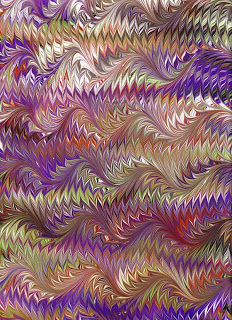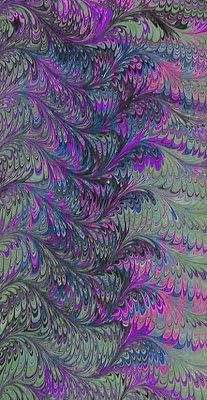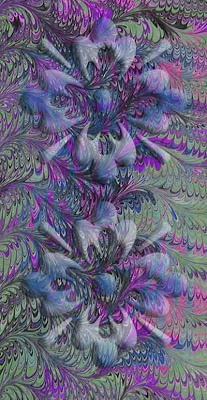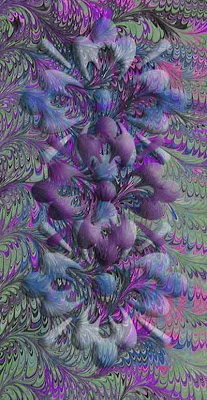Archive for the ‘creativity’ Category
Marketing 101

The time has come to seriously work at marketing. I already have a few events set up for these next 12 months, which is more than I have ever done. Now I need to find a way to balance marketing and blogging with actually creating art – so far blogging is winning….
I also need to think deeply about the relationship between the blog and creativity, with marketing the website and actually selling some art. While we are slowly solving our marbling problems, in reality I have plenty of large fabrics left for probably 15 new art pieces – as well as 1 or 2 just needing a few “extra” touches.
Part of the last few days has been exploring Google Analytics and Delicious, as well as a few others. I do read some blogs, but evidently I will need to do more commenting in order to build up my own following. So lots of thinking ahead in a totally different kind of creativity. Speaking of which, time to mark some papers….
I would love to hear from others as to how they balance marketing, thinking about marketing, 9-5 job, and making art….and why isn’t AdSense working???
Playing Around…

This is the original of a cactus in bloom at the Gardens last weekend. It’s smaller than I would like, but it still would make a good small print. I tried a lot of different filters and cropping and adjustments, until I was satisfied with this one. This is the “dry brush” filter, and I like the effect. It would not have worked without the bright pink blossoms for contrast.

Then I decided to take one of the pieces of marbled paper and see what I could do. This is a pattern, a variation of a chevron, that we have been trying to do and having no success with. So I might as well get some mileage out of this piece of paper. One example is the dry brush, after some color adjustments, and now I have a piece that could work with water. It seems like once we get a really good background we can then play with possibilities for a foreground image.
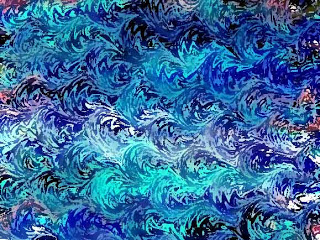
Here is a different chevron pattern. I did a lot of different filters and wasn’t satisfied. I reoriented it and was somewhat happier. I need to go back to some earlier lessons and review how to get a basic line drawing to work with – evidently not the “sharpen” filter – I think it’s the “blur” and then an “inverse.”
Then I really went to town with copying pieces of the pattern and putting them on a new layer and adjusting that layer, as well as using a few gradients. This is tentatively titled “Swimming Upstream.”
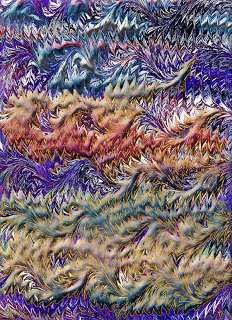
Thoughts for a Monday….

Another good school day, but I would rather have been at home working on art! I feel like some momentum is building, and I finally started some lists, mostly to organize and give me a jumping -off spot. My list from yesterday was very reasonable, and today I chose a few items from it and started to expand on them.
I checked on a fabric show in Colorado – I have had work accepted there before, and what’s even better is no entry fee. So I am contemplating Rain Forest (with a better picture), Pond, and On the Rocks. I need to read more on the prospectus so I know how many I can actually enter. What this process made me realize is that I don’t have a lot of ” new work.”
Did get approval from Amazon for an Associates page, so I can start developing that. With one of the very early versions of the website, I had an Amazon page, and we actually made money from it. ‘Course this was in the “early years” of the web and of Amazon. No clue how this will work now, but when I do the next newsletter, I will ask for suggestions, plus it gives me a chance to peruse Amazon – just have to remind myself that I don’t want to get sucked into stuff that isn’t actually making art.
Now for the reason for this entry. I was reading some old mail and deleting messages. I read The Future Buzz on a regular basis. This is one from February. 5 Simple Ways to Keep Your Mind Sharp. In a nutshell, here’s the five:
1) Continue reading, absorbing knowledge and experiencing culture.
2) Learn a skill or craft you’ve never tried before like playing an instrument, composing music, painting, building a model airplane, or even coding computer programs.
3) To improve memory don’t write everything down.
4) Give your mind time to assimilate knowledge.
5) Eat well, sleep well and exercise often.
Now What?

This is pretty much what I feel like right now – a maelstrom of ideas and lists and absolutely no idea where to start. The studio is set up and working wonderfully. I am sorting through sewing goodies (which I could spend hours on, not counting the fabrics, a classic delaying technique), school work is done for the weekend and a good chunk of next week. And I don’t know where to start.
Deadline for Fish Follies of April 25. One piece is finished – just needs some tightening of beads. Glacier – who knows? It’s waiting….and will probably continue to wait. Working on garden photos. Never sent in the trade name info (only been nine months). Want to scan old photos to preserve them. Want to purge stuff we don’t need in the new place…..
So I am facing what most artists do at some time or another. How do I get to a place to do meaningful work again, that will move me along as an artist, when I am overwhelmed with possibilities. All through the move and the math test, it was “just wait until you’re settled.” Well, that isn’t helping. I don’t want to make a list of things to do (like the abortive business plan from 5 years ago that just hung on the wall) because I will get overwhelmed and have even less of an idea of where to start.
I read marketing stuff (Future Buzz) and know I should be building the art business – no telling how many opportunities I have lost because I can’t get started……
I guess it’s time to call Suzan and at least do the change of address on the website – that in itself is seriously out of date……
What’s New….

So after a rather long hiatus of moving (the 7th time in nearly 15 years), studying (actually teaching myself calculus) in order to pass the secondary school math test, and trying to stay healthy, I am back to hopefully thinking more about art. In November Jane Dunnewold started a blog called Daily Visuals. She committed to taking daily pictures for inspiration, as well as teaching, and I have learned quite a bit.
I have always had a problem with focal points in my quilting. I have been so linear and always tried to work for symmetry (almost to a fault), that it has been very difficult to consciously work at creating a focal point. A few nights ago I was looking through my iPhoto gallery at some of the pics for the Tucson Botanical Gardens, a new favorite haunt. I started with some pics to see what I could do. I think they are good pictures to begin with, but I am looking to develop a great series called Garden Fantasy to offer to the Gardens for a show. Herewith my attempts….
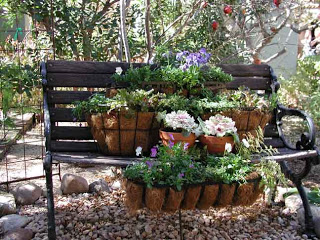
In one of the smaller gardens, there is this wonderful bench. I’m fascinated with the wood grain, as well as the color. Dean tries to frame the pictures as I tell him (suggest, actually), but there wasn’t anything to really grab you in this photo. So I tried cropping to change the basic elements. Here’s the resulting image:
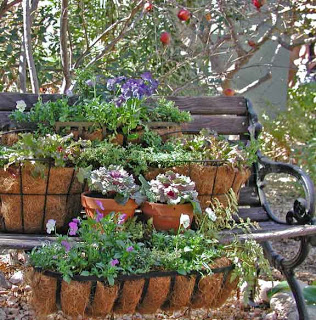
One end of the bench is spotlighted, with the wonderful curved arm. You can make out the red pomegrantes (sp?) in the upper right, and the eye tends to creep there and then come back to the center colors. The bench is more prominent this way, even though you don’t see the whole thing. I tried enhancing the greens of the leaves as well as the rusty-brown of the pots. Now that I can look at them together, while I am pleased with the overall composition, I think I lightened things too much. I like the darkness of the greens and browns in the first image, so I think I have more laying around to do.
Lots to learn….comments welcome!
History of Marbling, Part 2

The article has long been submitted – but here’s the rest of it!
Turning fabric into art was a long time coming. Dean and Linda worked initially to perfect their marbling skills on fabric, experimenting with tools to create patterns, as well as refining the pretreating process. Like the Middle Ages guilds that would keep marbling techniques secret, it was very difficult to get accurate information about tools, combs, and patterns. They learned the basic patterns of nonpareil, bouquet, stone, and chevron and experimented with free-flowing patterns and swirls. They started selling to crafters, quilters, and sewers interested in wearable art.
Marketing was originally limited to local groups, but after hearing the price to set up a website of their own, Linda undertook the steep learning curve of html in order to get their product out to the world. After 10-plus years on line, they worked with a web designer who also was a quilter and digital artist. Linda discovered the need for a more professional online portfolio that emphasized the artistic end of marbling, as opposed to the more commercial one of just selling fabric.
Linda stumbled into “fabric as art” at a meeting of a local critique group. She felt there was more that could be done with a piece of marbling. She and Dean loved creating new fabric, but they wanted a way to enjoy the truly great pieces. One new friend bought some fat quarters and came back to brunch the following week with a quilted and embellished wall-hanging – exactly what had been in the back of Linda’s mind but unable to exactly see. She started cutting and quilting strips and weaving them into unusual forms, leading to their first trunk show at Textures Gallery in Scottsdale, Arizona.
EBay provided an unexpected outlet of getting fabric out into the hands of fabric artists over the last three years. Blogging became a way of recording progress on art pieces, as well as musing about the artistic process. The realization that they wanted to do more than just create fabric to sell to others was no longer what they wanted to do. Dean joked that no fabric was safe from marbling – they would try to marble just about anything to see what would happen. Forget lace, velvet, nylon in favor of linen, velveteen, organza, brocades – and, yes, polyesters.
Now Dean and Linda have a dedicated studio space where potential half-yard pieces hang on the design wall, waiting for discussions about the stories they will tell. One of the most wonderful moments in learning marbling was realizing that a piece of fabric could tell an amazing story through simple lines and spaces of paint and color. One series is called Gaia, and the weavings focus on the abstract beauty of the planet, told through color, line, and shape, accented with quilting and embellishment. Another series explores the power of the mandala, the circle of life. Yet a third takes on the small beauties of everyday nature: the simple rock garden, the quiet pond, the rough water. Then there are other pieces that just have to be: a detailed rock, a comfort quilt for a friend, a stream for a geologist, a tide pool for an environmentalist. Using environmentally safe products and processes, it was a natural leap to develop series based on nature.
This art form has become a major part of their lives. It’s not only a chance to share their creativity with each other, but the two are able to bring different styles to the marbling. Dean is more studied in the dropping of paint, working very methodically. Linda likes the randomness of the paint globs and the unexpectedness of new designs. They love the study of a good piece of fabric to decide just what the finished story will be. They spend weekends when they are not marbling scouring galleries to breathe in art and look for interesting subjects and techniques that could carry over into the marbling process.
They experienced a two-year period where nothing about the marbling process worked. Fabrics from overseas were treated differently and it was harder to remove chemicals. Paint formulas changed, and certain colors were no longer bright and distinct. The local water wasn’t conducive to the marbling process. The worse part was feeling like they would never be able to marble large pieces of fabric again. They would take out special pieces and moon over them, wishing they could create again. One by one they eliminated problems and were finally able to marble once more.
There was no question that this was what they were meant to do together. Facing the two years without their marbling sessions was very difficult. For Dean especially, coming to marbling after years in wholesale/retail, this art form brought out hidden skills. For Linda, this was recognition that she could be an artist in a medium of her own, without criticism from others.
Sharing their art pieces with others still brings a thrill, especially when visitors watch the marbling process. The oohs and ahs as the patterns develop are like notes of joy from others as they see new beauty. One gallery owner, in jurying some pieces, said the work was amazing, gorgeous, and too high-end for her gallery. Feedback is important, and the list of accepted jury shows continues to grow. But for Dean and Linda Moran, and Marble-T Design, it will always be about the creative process.
Art with Abandon
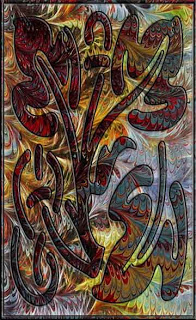
We were getting ready last week to do some marbling. We hadn’t done any in a bunch of weeks, and we hadn’t put anything up on ebay. We were really missing the actual making of fabric. During our New Year’s trip to Scottsdale, we both said we need to stop being so careful with the fabrics and designs. We always plan colors, patterns, and critique every piece.
We need to go back to the abandon and passion we had when we were first learning our craft. Stop worrying about perfect pieces – just have fun with creating.
I was reading an entry about how to be more creative and noticed this quote:
“Some of my best days producing creative material is when I stopped caring if I would produce something which was incorrect. Don’t worry about being right or wrong – just go for it. Your natural output uninhibited by concern for creating something correct or incorrect will always produce creative results.”
So bring on the paints, the different types of fabrics, grab a comb, start dropping paint, and stop worrying! Looking forward to using the big tray again!
More with Eric Maisel

As promised, here’s more with Eric Maisel, author of The Van Gogh Blues and creativity champion. I asked Eric a question concerning come of the frustrations I have been experiencing in teaching this year.
Me: I have come to see that for the immediate future my creativity is tied directly to my teaching middle school. I really work at making meaning when I am teaching, but I need some advice for my students. How do I help them make meaning? There is no light of learning in about 90 percent of them – they literally do not want to do the work – they will admit “I am lazy.” I always look beyond that to see what else might be going on (living out of a car, etc), but I really am stumped.This is a very low socio- economic area (I have never experienced poverty like this before in a school setting), and a failing school under No Child Left Behind. These kids have no record of school success for themselves – no sense of any intellectual meaning….
One of your comments (page 28, I think) is about how hard it is for professionals to stay away from depression, as opposed to interns and persons just starting out, since we have seen so much more. How do I help my kids?
Eric: I wonder if the answer, insofar as there is an answer, might not be in having (or allowing students to have) existential rather than curriculum-based discussions. What if students were asked to identify their most cherished values and to then try to imagine a life constructed around those values? Would they draw a blank, wax ironic, or find the task rich and useful? My hunch is that it is quite worth a try; one teacher reported to me that she engaged her third-graders (!) this way and that it make a remarkable difference in the way they self-regulated and tackled their work the whole school year. It would be grand to see meaning brought into the classroom—what could possibly be more important for students to think about and discuss?
I very much want to try more of this with my kids. I need to think about how to bring it in to the group, within the context o the classroom and the benefits of their education. Or maybe I just need to raise the issue of what is meaningful to them, and leave education completely out of the mix to start with. I would welcome comments and thoughts from you all!
Some other questions for Eric:
WHAT ADVICE DO YOU GIVE TO ARTISTS TO HANDLE THE POST-CREATION BLUES? The blues that happen when a project is done and you’ve worn yourself out.
Eric: Meaning must be made at all times or else we start to get those existential blues. But that isn’t to say that we can’t frame a day by the beach or a week incubating a project as meaningful time. The art is in our self-talk, where we consciously address our meaning needs by announcing where we want to invest meaning today: in a good rest, in a visit to the bookstore, in a little office organization, in a visit with a friend, and so on. What we want to guard against is the experience of meaninglessness that follows the completion of a project, and this we do by investing meaning wisely even though we may not have a new big project wanting to launch.
HOW CAN ARTISTS BEST FILL THE TIME IN PERIODS OF DORMANCY?
Eric: The answer revolves around how long the period of dormancy is and what the quality of that period is. If you tend to take three years off between projects, there is something going on there that needs to be addressed and you need to do a better job of forcing life to mean. If we’re taking about two weeks, that’s a very different matter. If it’s that shorter amount of time, then you can catch up on business matters (there is always something in that realm that needs doing), remind yourself why you love your art discipline by visiting a museum or reading a book, and passionately living your “parallel life,” that life of relationships and other meanings not connected to your creative projects.
ARTISTS OFTEN FACE CRITICISM IN THE FORM OF NOTES OR REVIEWS. HOW CAN AN ARTIST KEEP THEIR “SPIRIT UP” AND “FAITH IN THE WORK” IN THE FACE OF NEGATIVE FEEDBACK?
Eric: The first step is remember that everyone has an opinion, that great works have been roundly panned, and that you and you alone are the arbiter of meaning and quality in your life. If you don’t buy that at a visceral level, you will block when criticism comes. You have to have more than an intellectual understanding that your opinion must count the most: you must feel it in your bones. Once you possess that absolute certainty, then you can examine the criticism to see if there’s something there for you to learn—for often there is. The tricky dance is to reject all criticism while at the same time making use of feedback that serves you, a dance that no artist manages perfectly. Some err of the side of grandiosity and listen to no one; others, lacking in self-confidence, err in the direction of caving in and blocking.
SHOULD YOU FIGHT THE BLUES OR LET THEM COME?
Eric:It is my opinion that we should fight them, though not necessarily in the first five minutes or the first hour. Being in “that space” for a little while may be unavoidable and even necessary, but remaining in that painful place of inaction and despair has nothing really to recommend it. As soon as we can—and if we have gotten in the habit of disputing the blues, this will be sooner rather than later—we stand up tall, remind ourselves that we make the meaning in our life and that there is no meaning until we make it, and decide where we want to make our next meaning investment: in a new project, in the business of art, or in another sphere like relationships. If we can nip the blues in the bud before they even come by making that next meaning investment before meaninglessness even has a chance to rear its head, so much the better!
An Interview with Eric Maisel – Author of The Van Gogh Blues

Eric Maisel is a wonderful author, philosopher, and Renaissance man. Author of The Van Gogh Blues, he is stopping by today for an interview on creative people and depression. Sit back and enjoy!
Me: Eric, can you tell us what The Van Gogh Blues is about?
Eric: For more than 25 years I’ve been looking at the realities of the creative life and the make-up of the creative person in books like Fearless Creating, Creativity for Life, Coaching the Artist Within, and lots of others. A certain theme or idea began to emerge: that creative people are people who stand in relation to life in a certain way—they see themselves as active meaning-makers rather than as passive folks with no stake in the world and no inner potential to realize. This orientation makes meaning a certain kind of problem for them—if, in their own estimation, they aren’t making sufficient meaning, they get down. I began to see that this “simple” dynamic helped explain why so many creative people—I would say all of us at one time or another time—get the blues.
To say this more crisply, it seemed to me that the depression that we see in creative people was best conceptualized as existential depression, rather than as biological, psychological, or social depression. This meant that the treatment had to be existential in nature. You could medicate a depressed artist but you probably weren’t really getting at what was bothering him, namely that the meaning had leaked out of his life and that, as a result, he was just going through the motions, paralyzed by his meaning crisis.
Me: Are you saying that whenever a creative person is depressed, we are looking at existential depression? Or might that person be depressed in “some other way”?
Eric: When you’re depressed, especially if you are severely depressed, if the depression won’t go away, or if it comes back regularly, you owe it to yourself to get a medical work-up, because the cause might be biological and antidepressants might prove valuable. You also owe it to yourself to do some psychological work (hopefully with a sensible, talented, and effective therapist), as there may be psychological issues at play. But you ALSO owe it to yourself to explore whether the depression might be existential in nature and to see if your “treatment plan” should revolve around some key existential actions like reaffirming that your efforts matter and reinvesting meaning in your art and your life.
Me: So you’re saying that a person who decides, for whatever reason, that she is going to be a “meaning maker,” is more likely to get depressed by virtue of that very decision. In addition to telling herself that she matters and that her creative work matters, what else should she do to “keep meaning afloat” in her life? What else helps?
Eric: I think it is a great help just to have a “vocabulary of meaning” and to have language to use so that you know what is going on in your life. If you can’t accurately name a thing, it is very hard to think about that thing. That’s why I present a whole vocabulary of meaning in The Van Gogh Blues and introduce ideas and phrases like “meaning effort,” “meaning drain,” “meaning container,” and many others. When we get a rejection letter, we want to be able to say, “Oh, this is a meaning threat to my life as a novelist” and instantly reinvest meaning in our decision to write novels, because if we don’t think that way and speak that way, it is terribly easy to let that rejection letter precipitate a meaning crisis and get us seriously blue. By reminding ourselves that is our job not only to make meaning but also to maintain meaning when it is threatened, we get in the habit of remembering that we and we alone are in charge of keeping meaning afloat—no one else will do that for us. Having a vocabulary of meaning available to talk about these matters is a crucial part of the process.

Me: Could you explain more about the importance of creating a life plan sentence/statement?
Eric: If you agree to commit to active meaning-making, you need to know where to make your meaning investments, both in the short-term sense of knowing what to do with the next hour and in the long-term sense of knowing which novel you are writing or which career you’re pursuing. Having a life purpose statement or life plan statement in place serves as an ongoing reminder of the sorts of meaning investments that you intend to make, both short-term and long-term, and helps you make the right “meaning decision” about where to spend your capital and how to realize your potential.
Me: You list a number of core questions relating to creativity and making meaning in our lives. Do you feel that over time we will alternate between which question applies to us? Or is finding one question that applies to an artist is permanent, not changing over time?
Eric: There is no one question, just as there is no one meaning. The meaning-making process is a process of constant re-evaluation and ongoing analysis as we not only provide answers to our own questions but also provide ourselves with the right questions. For one period of time the questions may center on productivity, creativity, career, and the like, and during another period of time they may center on relationships, service, and the interpersonal sphere. Even on a single day, we might switch from asking ourselves one sort of question (about what project to tackle) to asking ourselves another sort of question (about how to help our addicted child or what to do about a community problem). Meaning shifts; so do the questions that we pose to ourselves about how to make and maintain meaning.
Me: What I hear you saying is that when creative people in particular maintain a connection to their mission or purpose (you call it a Life Purpose Statement in VGB), a connection to the value of their work, and their own value as creative people in the culture, they will be stronger in their work and in their lives. Is that a fair way to put it?
Eric: Yes. Even before you can make meaning, you must nominate yourself as the meaning-maker in your own life and fashion a central connection with yourself, one that is more aware, active, and purposeful than the connection most people fashion with themselves. Having some ideas about purpose is not the same as standing in relationship to yourself in such a way that you turn your ideas about purpose into concrete actions. Self-connection—understanding that you are your own advocate, taskmaster, coach, best friend, and sole arbiter of meaning and that no one else can or will serve those functions for you—is crucial.
Me: You mention that intimacy and personal relationships are as important to alleviating depression as are individual accomplishments. What is the link between the two and are they forged in similar ways?
Eric: It is important that we create and it is also important that we relate. Many artists have discovered that even though their creating feels supremely meaningful to them, creating alone does not alleviate depression. If it did, we would predict that productive and prolific creators would be spared depression, but we know that they have not been spared. More than creating is needed to fend off depression, because we have other meaning needs as well as the need to actualize our potential via creating. We also have the meaning need for human warmth, love, and intimacy: we find loving meaningful. Therefore we work on treating our existential depression in at least these two ways: by reminding ourselves that our creating matters and that therefore we must actively create; and by reminding ourselves that our relationships also matters, and that therefore we must actively relate.

Me: Do you think people creating in American culture have a more difficult time holding/making meaning for themselves and their work than creative workers in Europe, let’s say?
Eric: Yes. The very construction of European society, where people have more days off and more freedom to sit in a café and write, draw, dream, or chat, makes it easier for people to deeply consider how they what to represent themselves and how they want to make themselves proud. That is why European movies are “more meaningful” than American movies: our culture is dominated by the idea of happy endings and by clichéd and superficial examinations of the facts of existence. Because of our insidious pop culture, mass media, and bottom line-driven dynamics, it is harder for a creative person here to feel motivated to do the kind of meaningful work that is in his or her heart to do.
Me: Do you find any difference between creative media in how the process of losing meaning can happen? Do painters and writers or musicians and actors have a substantially different experience, or is the core of the experience the same?
Eric: There are many angles to this question, but let me focus on just two. Visual artists often produce one-of-a-kind products and have a hard time finding it meaningful that just one person will own that product, whereas writers can reach multiple “customers” with their creations. So the visual artist has to make personal sense of this issue and figure out how to let it “still be meaningful” that her painting may end up on the wall of a doctor’s waiting room or as one among many paintings in a collector’s back room. On an entirely different note, re-creative artists like actors and musicians often have to deal with the feeling that they are “only” serving the meaning needs of others—the composer, the screenwriter, the director—and often decide that they must also create as well as re-create: put on a one-woman show, put out an album of their own music, etc. These are just a few of the differences that arise among the different genres and disciplines.
Me: In Van Gogh Blues you mention some of the difficulties that can occur in creative communities when creators attempt to come together and connect with one another. You also refer to “marvels of relating,” a phrase I love. What are some steps we can take to improve our chances of giving and receiving these “marvels of relating” within creative community?
Eric: The most important internal movement is toward the belief that other people exist and that other people count. It is very easy to drift from taking sole responsibility for your meaning-making efforts, which is good thing, to a grandiose, arrogant, selfish, and narcissistic place where “only you count.” On the other side of the coin, if you grew up in an environment where the messages you received were about being seen and not heard, about blending in and not standing up for yourself, and so on, then you need to find the courage to stand up for yourself, to maintain healthy boundaries, and to exert your power as the meaning-maker of your own life. One artist may have as his central task treating others better; another artist may have as her central task standing up taller.
Me: You write about the difference between busyness and action. Could you give my readers a sample of the self-talk an artist needs to being thinking when she steps boldly into action?
Eric: The first step is to completely stop—not to slow down but to completely stop. Learning how to do this (and it isn’t easy, especially in our culture that promotes speed, fracture, and a short attention span) makes all the difference in a creative person’s life, as internal busyness is completely eliminated if in fact you actually stop, quiet your mind, and allow yourself to calmly grow present. The self-talk is exactly “I am completely stopping,” followed by the idea that you intend to calmly create without worrying about outcomes—that you are just intending to be present and to do your work. If a doubt or a worry intrudes, you dispute it by saying “I’m not interested in that doubt” or “I reject that worry,” return yourself to deep silence, and continue “just working.”
Me: When she feels the blues descending, what questions could an artist ask herself to locate the source of her discontent?
Eric: A medical work-up is a good idea, especially if her depressions in the past have been severe or long-lasting, as the coming depression might possibly be avoided with antidepressants (if it the “right” sort of depression). She can also engage in some simple “home remedies”: exercise is a depression-fighter, as is getting out in the sun. From an existential point of view, what she wants to ask herself is if her current creative work matters to her—if at some level it doesn’t, she will need to reinvest meaning in it by telling herself that she and it do matter; or, if she can’t imbue it with meaning, she will need to turn to other, more meaningful work.
Me: What might a person interested in these issues do to keep abreast of your work?
Eric: They might subscribe to my two podcast shows, The Joy of Living Creatively and Your Purpose-Centered Life, both on the Personal Life Media Network. You can find a show list for The Joy of Living Creatively here and one for Your Purpose-Centered Life here. They might also follow this tour, since each host on the tour will be asking his or her own special questions. Here is the complete tour schedule. If they are writers, they might be interested in my new book, A Writer’s Space, which appears this spring and in which I look at many existential issues in the lives of writers. They might also want to subscribe to my free newsletter, in which I preview a lot of the material that ends up in my books (and also keep folks abreast of my workshops and trainings). But of the course the most important thing is that they get their hands on The Van Gogh Blues!—since it is really likely to help them.
MORE TOMORROW! Some additional questions you might find interesting – and I will be writing for Eric’s creativity blog, starting in March. His work has been incredibly helpful.
Getting Better at This….

It does feel good to get back to doing work with Photoshop – pretty productive weekend, and I still continue to learn lots. I have been experimenting with additional shapes in the library – definitely need to add more. But this is a great way to work with layers and see how everything interacts together. This piece has as its original, the same piece from the purple flower below, but this time tinted with a yellow hue. In this one, Spring, you can see the original shape I used on its own layer.
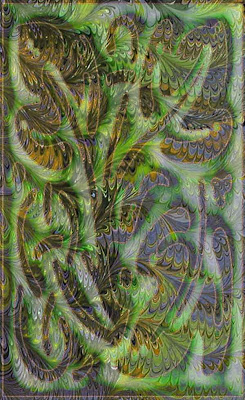
I tried to do more to get this idea of spring/summer across, without making the shape look too much like a Photoshop shape.
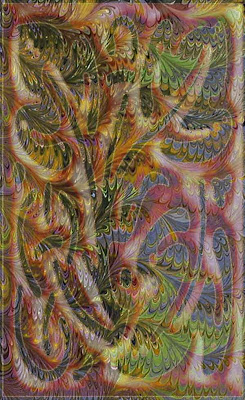
Then I just started playing around till I got what I’m calling “Asian Fantasy.”
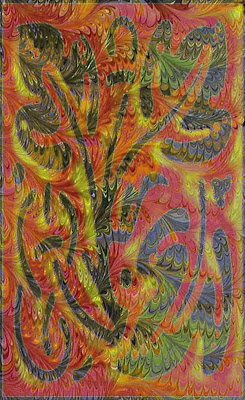
Here are two other iterations (that seems to be my word for the day!!) –
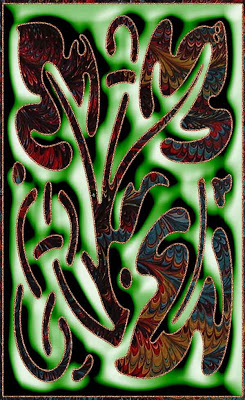
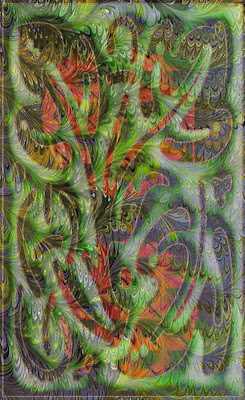
Some New Playing Around….

After a great workout at the spa and a nice lazy afternoon, I decided to get involved with some new Photoshop stuff. I am anticipating a visit to a gallery next weekend – sent the letter and DVD off in the mail yesterday – so it’s time to continue making some new work. What follows is the original – and I had a lot of fun adjusting hue on this for a variety of looks.
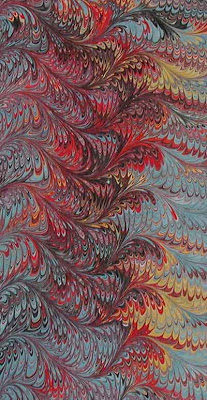
From here I started with the purple.
Then I wanted to look at some shapes. I am still not happy with the shape library, but I was trying a couple and ended up with a nice stylized piece.
And the final version – at least, it’s final until Suzan works her magic. I tried several others first today, and I wasn’t really happy. This one is close to being a “wow.”
Depression and Creativity

I am amazed at how many of us are struggling in our teaching because of the weight of what we do. As I’ve written before, I have come to see teaching as my primary creative activity for at least a few more years. I am reading
The Van Gogh Blues
by Eric Maisel, and there was a wonderful quote in the beginning:
“What could be odder than to have no doubt while having no success and then tremendous doubt as soon as a great success hits? How upside down that sounds! Yet isn’t the experienced cleric more prone to doubt than the seminary student, the experienced therapist more prone to doubt than the intern, the experienced professional in any field more prone to despair and meaning loss than the innocent who still believes?” (p. 28)
That’s a powerful statement, and it speaks to my looking at this issue further. Eric Maisel will be appearing here on this blog to talk about this and other issues on February 20th. I am finding the book fascinating reading, but while I may be helped, I can’t help but wonder about the overall state of education and creativity.
On Art Markers

I had a former graffiti artist in to school to talk about his work and the fact that he had been arrested and incarcerated for graffiti. One of the boys is interested, and this is all part of the global problems we are working on. He brought in all the sketchbooks for the kids to see – some really great ideas, and stuff the kids could relate to.
What amazed me was the markers. Felt tip has come a long way – and as he said, they’re 5 dollars a piece. What I thought was watercolor was really marker. And I loved the accented lines and outlines that he created – I can see the beauty in this style – and it would be good to be able to bring some of this stuff to the kids – they could see a different type of art, and he makes a living with his art.
One of the things that made me feel old was in the questions the kids were asking, about “crews” and “productions.” I had no idea what they were talking about. Turns out a crew is a group of graffiti artists who worked together. A production is a challenge, or battle, between two graffiti groups to fill up a wall, to see who would be the better group of artists. I love the idea of an art challenge, or battle, to create art.
The kids would probably get into this style of art, as well as taking to scrapbooking. I could use a digital camera for those students who have no family pictures – I think enough teachers have scrapbook tools they could lend.
Kinda Mellow….

It has been a very nice two weeks of vacation. I finished up my lesson plans last night, knowing full well if I didn’t I would hate myself today. So by 9 PM last night I had everything packed to go for Monday morning. A tradition for the last couple of years has been to have dinner with Ali so I don’t stew about going back to school. We didn’t do it this August because I thought I was okay, but I really missed our getting together for dinner.
I met with Yvonna today for breakfast. It is worse other places. We started teaming together almost 7 years ago in the sixth grade. We hit it off right away – two intellectual, smart women with the same approach to kids and teaching. We don’t see each other as often, so we always have lots to catch up on. Both of us are having a hard time coping with the changes in education and what we are being forced to do as a result of district demands. One thing I said to her, and again to Sam who is so depressed about going back, is that we have to remember at this time in education we have a mission to try and do what is right by our students, regardless of the roadblocks. This is a battle I am choosing to fight. Right now the most creative thing I can do is attempt to reach my kids despite teaching to a flawed test.
I took care of a lot of loose ends today, left over from my list-making on Thursday. I did very well. I have a huge list of loose ends for tomorrow and the rest of the week, but these are mostly so I don’t have to remember them and worry about forgetting and not having what I need for class. I ordered the 100 free postcards from VistaPrint – took me an hour to work through all the sizing and the problems with downloading. But – should be on the way in a couple of weeks. I chose the Cosmos piece, since it shows both the marbling and the digital manipulation.

I had a bit of an epiphany concerning my art classes, and I am going to dwell on this to get me through the remaining 92 days till summer. Maybe Fate decided it would be good for me to have art classes, as now I have a chance to feed children’s souls, beyond the testing situations. I have a chance to show them art, to explore ideas, to give them a taste of what they can do by following their artistic side.
A Good Marbling Session

We had another good session for marbling – a lot of remnants, plus a couple of good pieces of silk – and another good piece of velveteen – which we haven’t done in a while. Three hours, start to end of clean-up today, but that’s not counting the two hours of prep yesterday, plus the hour Dean spent getting paints ready for today. Nice and relaxing, everything worked. As we get ready to think about doing a new preferred letter, we have to look at how much product we can do with tight space and my not always being available. As we don’t do as much fabric any more, we don’t have to worry about taking one whole day of the weekend for the actual marbling.
I can feel myself getting depressed today, knowing that school vacation is almost over, and I still need to get ready – which I’ve allowed time for before Sunday, but I still have enjoyed the days so much, and I really don’t want to get back into the grind. I’ve started walking again, relaxing, getting my nails done, and I am SO looking forward to eventual retirement. At least I can “retire” periodically through the school year and then all summer.
I need to finish my Photoshop class, but the projects really aren’t interesting me, as I would rather look at the tutorials on NAPP and work from there. But I have learned so much from those lessons and developed a lot of confidence in what I am doing. There’s no big deal to finishing, just that it’s a loose end that I would like to take care of. I have discovered that I am really not into photo retouching or restoring per se – I like the original creations.
That said, I need to go read a few tutorials and work on a new piece tonight.
